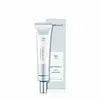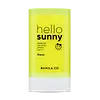Thank You Farmer Sun Project Light Sun Essence SPF50+ PA+++ Versus Banila Co Hello Sunny Essence Sun Stick SPF 50+
What's inside
What's inside
 Key Ingredients
Key Ingredients

 Benefits
Benefits

 Concerns
Concerns

 Ingredients Side-by-side
Ingredients Side-by-side

Water
Skin ConditioningEthylhexyl Methoxycinnamate
UV AbsorberHomosalate
Skin ConditioningEthylhexyl Salicylate
UV AbsorberDiethylamino Hydroxybenzoyl Hexyl Benzoate
UV FilterButylene Glycol
HumectantOctocrylene
UV AbsorberDicaprylyl Carbonate
EmollientCyclopentasiloxane
EmollientC20-22 Alkyl Phosphate
EmulsifyingC20-22 Alcohols
Emulsion StabilisingSilica
Abrasive1,2-Hexanediol
Skin ConditioningPortulaca Oleracea Extract
Skin ConditioningNelumbo Nucifera Flower Water
TonicGlycine Soja Lipids
Skin ConditioningEchium Plantagineum Seed Oil
Skin ConditioningAloe Barbadensis Leaf Extract
EmollientAlthaea Rosea Flower Extract
Skin ConditioningCardiospermum Halicacabum Flower/Leaf/Vine Extract
Skin ConditioningHelianthus Annuus Seed Oil Unsaponifiables
EmollientPlukenetia Volubilis Seed Oil
EmollientCetyl Alcohol
EmollientGlyceryl Stearate
EmollientGlycerin
HumectantTromethamine
BufferingPolyacrylate Crosspolymer-6
Emulsion StabilisingOctyldodecanol
EmollientGlyceryl Caprylate
EmollientCaprylyl Glycol
EmollientMicrocrystalline Cellulose
AbsorbentXanthan Gum
EmulsifyingSodium Acrylate/Sodium Acryloyldimethyl Taurate Copolymer
Emulsion StabilisingPolyisobutene
Ethylhexylglycerin
Skin ConditioningGlyceryl Polymethacrylate
Cellulose Gum
Emulsion StabilisingSorbitan Oleate
EmulsifyingCaprylyl/Capryl Glucoside
CleansingParfum
MaskingWater, Ethylhexyl Methoxycinnamate, Homosalate, Ethylhexyl Salicylate, Diethylamino Hydroxybenzoyl Hexyl Benzoate, Butylene Glycol, Octocrylene, Dicaprylyl Carbonate, Cyclopentasiloxane, C20-22 Alkyl Phosphate, C20-22 Alcohols, Silica, 1,2-Hexanediol, Portulaca Oleracea Extract, Nelumbo Nucifera Flower Water, Glycine Soja Lipids, Echium Plantagineum Seed Oil, Aloe Barbadensis Leaf Extract, Althaea Rosea Flower Extract, Cardiospermum Halicacabum Flower/Leaf/Vine Extract, Helianthus Annuus Seed Oil Unsaponifiables, Plukenetia Volubilis Seed Oil, Cetyl Alcohol, Glyceryl Stearate, Glycerin, Tromethamine, Polyacrylate Crosspolymer-6, Octyldodecanol, Glyceryl Caprylate, Caprylyl Glycol, Microcrystalline Cellulose, Xanthan Gum, Sodium Acrylate/Sodium Acryloyldimethyl Taurate Copolymer, Polyisobutene, Ethylhexylglycerin, Glyceryl Polymethacrylate, Cellulose Gum, Sorbitan Oleate, Caprylyl/Capryl Glucoside, Parfum
Octyldodecanol
EmollientPropylheptyl Caprylate
EmollientOctocrylene
UV AbsorberButylene Glycol Dicaprylate/Dicaprate
EmollientEthylhexyl Methoxycinnamate
UV AbsorberDicaprylyl Carbonate
EmollientDibutyl Lauroyl Glutamide
Skin ConditioningEthylhexyl Salicylate
UV AbsorberDextrin Palmitate
EmulsifyingDibutyl Ethylhexanoyl Glutamide
Skin ConditioningDiethylamino Hydroxybenzoyl Hexyl Benzoate
UV FilterBis-Ethylhexyloxyphenol Methoxyphenyl Triazine
Skin ConditioningSilica Silylate
EmollientTocopheryl Acetate
AntioxidantBisabolol
MaskingCitrus Aurantium Dulcis Oil
MaskingLavandula Angustifolia Oil
MaskingCitrus Nobilis Peel Oil
MaskingDehydroacetic Acid
PreservativeEchium Plantagineum Seed Oil
Skin ConditioningLitsea Cubeba Fruit Oil
MaskingAnthemis Nobilis Flower Oil
MaskingHelianthus Annuus Seed Oil Unsaponifiables
EmollientCardiospermum Halicacabum Flower/Leaf/Vine Extract
Skin ConditioningTocopherol
AntioxidantWater
Skin ConditioningBetula Alba Juice
AstringentButylene Glycol
HumectantOenothera Biennis Flower Extract
Astringent1,2-Hexanediol
Skin ConditioningHypnea Musciformis Extract
Skin ProtectingUlva Lactuca Extract
Skin ConditioningEcklonia Cava Extract
Skin ConditioningCodium Tomentosum Extract
Skin ProtectingAgarum Cribrosum Extract
Skin ConditioningEnteromorpha Compressa Extract
Skin ProtectingLaminaria Japonica Extract
Skin ProtectingDunaliella Salina Extract
Skin ConditioningSargassum Fulvellum Extract
Skin ConditioningSargassum Muticum Extract
Skin ProtectingPorphyra Tenera Extract
Skin ConditioningSpirulina Platensis Extract
Skin ProtectingJania Rubens Extract
Skin ConditioningGelidium Cartilagineum Extract
Skin ProtectingEuglena Gracilis Extract
Skin ConditioningMacrocystis Pyrifera Extract
Skin ConditioningUndaria Pinnatifida Extract
Skin ConditioningCodium Fragile Extract
Skin ConditioningLaminaria Cloustoni Extract
Skin ProtectingCladosiphon Okamuranus Extract
Skin ConditioningChlorella Vulgaris Extract
Skin ConditioningSalicornia Herbacea Extract
Skin ConditioningPhenoxyethanol
PreservativePlankton Extract
Skin ConditioningPikea Robusta Extract
AntioxidantHydrolyzed Ulva Lactuca Extract
Skin ConditioningHaematococcus Pluvialis Extract
AntioxidantLaminaria Digitata Extract
Skin ProtectingDisodium EDTA
Ethylhexylglycerin
Skin ConditioningMacrocystis Pyrifera Protein
Skin ConditioningHydrolyzed Enteromorpha Compressa
Skin ConditioningOctyldodecanol, Propylheptyl Caprylate, Octocrylene, Butylene Glycol Dicaprylate/Dicaprate, Ethylhexyl Methoxycinnamate, Dicaprylyl Carbonate, Dibutyl Lauroyl Glutamide, Ethylhexyl Salicylate, Dextrin Palmitate, Dibutyl Ethylhexanoyl Glutamide, Diethylamino Hydroxybenzoyl Hexyl Benzoate, Bis-Ethylhexyloxyphenol Methoxyphenyl Triazine, Silica Silylate, Tocopheryl Acetate, Bisabolol, Citrus Aurantium Dulcis Oil, Lavandula Angustifolia Oil, Citrus Nobilis Peel Oil, Dehydroacetic Acid, Echium Plantagineum Seed Oil, Litsea Cubeba Fruit Oil, Anthemis Nobilis Flower Oil, Helianthus Annuus Seed Oil Unsaponifiables, Cardiospermum Halicacabum Flower/Leaf/Vine Extract, Tocopherol, Water, Betula Alba Juice, Butylene Glycol, Oenothera Biennis Flower Extract, 1,2-Hexanediol, Hypnea Musciformis Extract, Ulva Lactuca Extract, Ecklonia Cava Extract, Codium Tomentosum Extract, Agarum Cribrosum Extract, Enteromorpha Compressa Extract, Laminaria Japonica Extract, Dunaliella Salina Extract, Sargassum Fulvellum Extract, Sargassum Muticum Extract, Porphyra Tenera Extract, Spirulina Platensis Extract, Jania Rubens Extract, Gelidium Cartilagineum Extract, Euglena Gracilis Extract, Macrocystis Pyrifera Extract, Undaria Pinnatifida Extract, Codium Fragile Extract, Laminaria Cloustoni Extract, Cladosiphon Okamuranus Extract, Chlorella Vulgaris Extract, Salicornia Herbacea Extract, Phenoxyethanol, Plankton Extract, Pikea Robusta Extract, Hydrolyzed Ulva Lactuca Extract, Haematococcus Pluvialis Extract, Laminaria Digitata Extract, Disodium EDTA, Ethylhexylglycerin, Macrocystis Pyrifera Protein, Hydrolyzed Enteromorpha Compressa
 Reviews
Reviews

Ingredients Explained
These ingredients are found in both products.
Ingredients higher up in an ingredient list are typically present in a larger amount.
1,2-Hexanediol is a synthetic liquid and another multi-functional powerhouse.
It is a:
- Humectant, drawing moisture into the skin
- Emollient, helping to soften skin
- Solvent, dispersing and stabilizing formulas
- Preservative booster, enhancing the antimicrobial activity of other preservatives
Butylene Glycol (or BG) is used within cosmetic products for a few different reasons:
Overall, Butylene Glycol is a safe and well-rounded ingredient that works well with other ingredients.
Though this ingredient works well with most skin types, some people with sensitive skin may experience a reaction such as allergic rashes, closed comedones, or itchiness.
Learn more about Butylene GlycolCardiospermum halicacabum extract is more commonly known as Balloon Vine Extract.
Balloon Vine Extract helps soothe skin and is an antioxidant. It also contains many fatty acids, such as palmitic, oleic, and stearic acids. While these fatty acids help soften skin, they may not be fungal-friendly.
Antioxidants help fight free-radicals. Free-radicals are molecules that may damage your skin cells, such as pollution.
Balloon Vine has been used in traditional medicine in many Asian cultures.
Learn more about Cardiospermum Halicacabum Flower/Leaf/Vine ExtractDicaprylyl Carbonate comes from carbonic acid and caprylyl alcohol, a fatty alcohol. It is an emollient and gives skin a velvet feel. The sources of Dicaprylyl Carbonate may be synthetic or from animals.
As an emollient, Dicaprylyl Carbonate creates a film on the skin. This film traps moisture in, keeping your skin soft and hydrated.
Diethylamino Hydroxybenzoyl Hexyl Benzoate (DHHB) is a chemical UV-A absorber. It is formulated for high UVA protection (320-400 nm).
DHHB is well-liked for:
DHHB has been approved by the EU, Japan, Taiwan, and South America for use up to 10%. Unfortunately, it has not been approved for use in the US or Canada due to slow regulatory processes.
This ingredient is soluble in oils, fats, and lipids.
Learn more about Diethylamino Hydroxybenzoyl Hexyl BenzoateEchium Plantagineum Seed Oil is an oil and isn't fungal acne safe.
Ethylhexyl Methoxycinnamate is an organic compound that provides UVB protection. It often goes by the more common name of octinoxate. It is created from methoxycinnamic acid and 2-ethylhexanol.
Ethylhexyl Methoxycinnamate absorbs UVB rays with wavelengths between 280-320 nm. UV absorbers protect your skin by using chemical reactions to convert UV rays into heat and energy.
UVB (290-320 nm) rays emit more energy than UVA rays. They are capable of damaging DNA, causing sunburns and are thought to be linked to skin cancer.
The state of Hawaii has banned sunscreens containing octinoxate due to its potential impact on coral reefs. More research is needed to bridge gaps in this research. The European Union allows higher levels of octinoxate in sunscreens than the US and Australia.
Ethylhexyl Methoxycinnamate is oil soluble. It is not stable and may lose efficacy when exposed to sunlight.
Learn more about Ethylhexyl MethoxycinnamateEthylhexyl Salicylate is an organic compound used to block UV rays. It primarily absorbs UVB rays but offers a small amount of UVA protection as well.
Commonly found in sunscreens, Ethylhexyl Salicylate is created from salicylic acid and 2-ethylhexanol. You might know salicylic acid as the effective acne fighter ingredient and BHA.
The ethylhexanol in this ingredient is a fatty alcohol and helps hydrate your skin, similar to oils. It is an emollient, which means it traps moisture into the skin.
According to manufacturers, Ethylhexyl Salicylate absorbs UV wavelength of 295-315 nm, with a peak absorption at 307-310 nm. UVA rays are linked to long term skin damage, such as hyperpigmentation. UVB rays emit more energy and are capable of damaging our DNA. UVB rays cause sunburn.
Learn more about Ethylhexyl SalicylateEthylhexylglycerin (we can't pronounce this either) is commonly used as a preservative and skin softener. It is derived from glyceryl.
You might see Ethylhexylglycerin often paired with other preservatives such as phenoxyethanol. Ethylhexylglycerin has been found to increase the effectiveness of these other preservatives.
Helianthus Annuus Seed Oil Unsaponifiables is an oil and isn't fungal acne safe.
Octocrylene protects skin from sun damage. It absorbs UV-B with peak absorption of 304 nm. It is a common sunscreen ingredient and often paired with avobenzone, a UVA filter. This is because octocrylene stabilizes other sunscreen ingredients by protecting them from degradation when exposed to sunlight. Octocrylene is a photostable ingredient and loses about 10% of SPF in 95 minutes.
Octocrylene also acts as an emollient, meaning it helps skin retain moisture and softens skin. It is oil-soluble and hydrophobic, enhancing water-resistant properties in a product.
Those who are using ketoprofen, a topical anti-inflammatory drug, may experience an allergic reaction when using octocrylene. It is best to speak with a healthcare professional about using sunscreens with octocrylene.
The EU allows a maximum of these concentrations:
Learn more about OctocryleneOctyldodecanol is a fatty alcohol. It is primarily used to enhance the texture of products.
As an emulsifier, Octyldodecanol helps prevent the oils and waters from separating. It also prevents ingredients from creating foam when shaken.
Octyldodecanol is created by reducing fatty acid to an alcohol.
Due to its high molecular weight, it does not get absorbed into the skin.
Learn more about OctyldodecanolWater. It's the most common cosmetic ingredient of all. You'll usually see it at the top of ingredient lists, meaning that it makes up the largest part of the product.
So why is it so popular? Water most often acts as a solvent - this means that it helps dissolve other ingredients into the formulation.
You'll also recognize water as that liquid we all need to stay alive. If you see this, drink a glass of water. Stay hydrated!
Learn more about Water